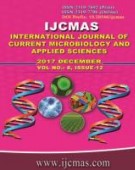


 National Academy of Agricultural Sciences (NAAS)
National Academy of Agricultural Sciences (NAAS)

|
PRINT ISSN : 2319-7692
Online ISSN : 2319-7706 Issues : 12 per year Publisher : Excellent Publishers Email : editorijcmas@gmail.com / submit@ijcmas.com Editor-in-chief: Dr.M.Prakash Index Copernicus ICV 2018: 95.39 NAAS RATING 2020: 5.38 |
Integrated nutrient management through biofertilizers, organic fertilizer and chemical fertilizers can sustain soil quality and improve plant growth. A field experiment titled “Effect of Biofertilizer and Integrated Nutrient Management on Growth of Potato and Soil Microbial Activity” was conducted during rabi seasons of 201415 and 201516 at the instructional cum research farm of Assam agricultural university. The experiment consisting of eight treatments viz., 100% recommended dose of Nitrogen (T1), 75% recommended dose of Nitrogen+ 25% Nitrogen through Enriched Compost (T2), 75% recommended dose of Nitrogen+ 25% Nitrogen through Vermicompost (T3), 50% recommended dose of Nitrogen+ 50% Nitrogen through Enriched Compost (T4), 50% recommended of Nitrogen + 50% Nitrogen through Vermicompost (T5),50% recommended dose of Nitrogen + 25% Nitrogen through Enriched Compost + 25% Nitrogen through Vermicompost (T6), 50% recommended dose of Nitrogen + 25% Nitrogen through Enriched Compost (T7) and 50% recommended dose of Nitrogen + 25% Nitrogen through Vermicompost (T8) was laid out in randomized block design with three replications. The soil of the experimental site was sandy loam in texture, acidic (5.66) in reaction, medium in organic carbon (0.72%), available N (290kg/ha), P2O5 (25.78kg/ha) and K2O (270.89kg/ha).Soil physicochemical characters at harvest of potato were significantly influenced by INM practices of which T6 (50% recommended dose of Nitrogen + 25% Nitrogen through Enriched Compost + 25% Nitrogen through Vermicompost) recorded the highest values for all the soil parameters viz., soil pH (5.58 and 5.62), soil organic carbon (SOC) (0.96 and 1.08%), available N (405 and 548.15 kg/ha), P (23.20 and 23.96 kg/ha) and K (333.89 and 336.55 kg/ha) during both the years of experimentation. Soil biological characters were also found to be statistically superior in respect of microbial biomass carbon (335.55 and 367.41μg g1 soil), dehydrogenase activity (191.29 and 201.19 μg TPFg124hr1), phosphomonoesterase activity (356.44 and 382.46 μg p-nitrophenol g1hr1), fluorescein diacetate hydrolysis activity (9.22 and 9.26 μg fluorescein g1 hr1) at T6 followed by T4 (50% recommended dose of Nitrogen + 50% Nitrogen through Enriched Compost). The Organic carbon showed strong correlation with microbial biomass carbon (r=0.794*), Dehydrogenase (r=0.807**) and Available N (r=0.700*). Similarly the enzyme phosphomonoesterase established significant correlation with Available P2O5 (r=0.668*) indicating the role of enzyme in releasing the P from organic sources.
 |
 |
 |
 |
 |